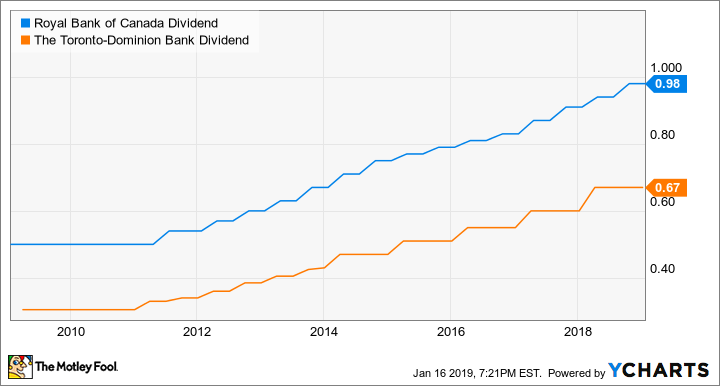3 Reasons to Own the Top Canadian Banks in Your Portfolio

The big Canadian banks are in an oligopoly, in which there’s enough competition to keep them improving but not so much competition that one is eating the lunch of another in the Canadian market.
Making billions of dollars with growing earnings
The top Canadian banks, including Royal Bank of Canada (TSX:RY)(NYSE:RY) and Toronto-Dominion Bank (TSX:TD)(NYSE:TD), are highly profitable. In fiscal 2018, they reported net income of $12.4 billion and $11.3 billion, respectively. Their recent net margins were 21.6% and 21.5%, respectively.
RY Net Income (TTM) data by YCharts. Long-term net income trend of Royal Bank and TD Bank.
The banks are time-tested businesses that will make money in all kinds of economic environments. Through recessions, the banks survived and came out thriving. From fiscal 2007 (right before the last recession hit) to fiscal 2018, Royal Bank increased its earnings per share by about 6.5%. In the same period, TD Bank’s earnings per share climbed 7.6%.
Stocks with businesses that become more profitable over time appreciate over time. From fiscal 2007 to 2018, Royal Bank delivered total returns of 7.6%. About 76% of the returns were from price appreciation and 24% was from dividends. TD Bank delivered total returns of 8.5% in the period. About 78% of the returns was from price appreciation and 22% was from dividends.
Growing dividends
Growing earnings lead to safe and sustainably growing dividends. From fiscal 2007 to 2018, Royal Bank increased its dividend per share by about 6.8% on average per year. In the same period, TD Bank increased its dividend per share by 8.6% on average per year.
RY Dividend data by YCharts. The 10-year dividend growth history of Royal Bank and TD Bank.
Typically, a lower payout ratio and higher earnings growth result in faster dividend growth. As shown in the past 11 years, TD Bank delivered higher dividend growth, as it increased its earnings per share faster and began the period with a payout ratio of 37% and ended the period with a payout ratio of 41%. In the same period, Royal Bank’s payout ratio expanded from about 43% to 45%.
Portfolio stabilizer
There’s no helping it that stock portfolios are riskier and more volatile than fixed-income investments. However, investors can selectively build a diversified portfolio of low-risk, high-quality stocks. The top Canadian banks are such stocks. Both Royal Bank and TD Bank serve as stock portfolio stabilizers.

This is not to say that their stocks won’t fall greatly in freaky markets. In fact, they did in the last recession that was triggered by a financial crisis. However, their profitability remained largely intact, and they also maintained their dividends. It took about six months for the stocks to recover from the financial crisis bottom to the pre-recession levels before the stocks moved steadily higher.
After the recession scare, from late 2009, Royal Bank stock and TD Bank stock have delivered annualized returns of 8.7% and 10.6%, respectively. So, recessions are not to be feared. On the contrary, investors should invest more heavily in quality stocks during times of fear.
Investor takeaway
If you hold the top Canadian banks, you can consider them as a part of your core portfolio. In my books, those are candidates of “hold forever” stocks. Additionally, they offer yields of about 4%, which come in the form of dividend paycheques every three months. If I had to choose one to buy now, I’d choose TD Bank, which trades at a slightly lower multiple but is estimated to increase its earnings at a higher pace.
For the next three to five years, Thomson Reuters analysts estimate Royal Bank and TD Bank will grow their earnings per share by about 8% and 12%, respectively.
More reading
Tax-Free Fortune: 2 Stocks to Pay You $5,000 a Year With a $50,000 TFSA
Will Aurora Cannabis Inc. (TSX:ACB) Stock Hit Double Digits This Winter?
Fool contributor Kay Ng owns shares of The Toronto-Dominion Bank.

 Yahoo Finance
Yahoo Finance 

